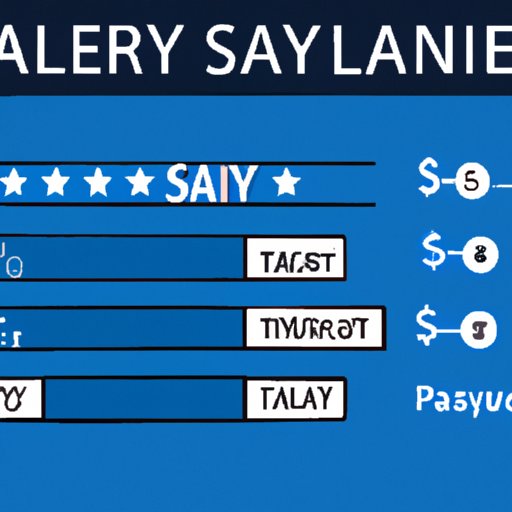Introduction
Salary pay is one of the most common forms of payment for employees. In this article, we’ll explore how salary pay works, the different types of salary structures, advantages and disadvantages, how it differs from hourly pay, factors that impact salary pay, and the tax implications of salary pay.

Explaining the Basics of How Salary Pay Works
To understand how salary pay works, let’s first define what salary pay is. According to Investopedia, “Salary pay is an agreement between an employer and an employee, where the employee agrees to work for a set amount of money over a specific period of time.”
The amount of money and frequency of payments are determined by the employer and employee. Generally, salary pay is based on an annual figure divided into 12 equal payments, but there are other ways in which salary pay can be calculated, such as bi-weekly or monthly payments. Employers may also offer bonuses or incentives.
When calculating salary pay, employers must consider taxes and deductions. Employers are required to withhold taxes, including income tax and Social Security contributions, and may deduct additional amounts for health insurance, retirement plans, and other benefits.

Examining Different Types of Salary Pay Structures
There are several different types of salary pay structures. The most common type is a fixed salary, which is a predetermined amount of money that does not change based on performance. Alternatively, employers may opt for a variable salary, which is an amount of money that is subject to change based on certain criteria, such as sales performance or hours worked.
Incentive-based salaries are becoming increasingly popular. This type of salary structure pays employees a base salary plus bonuses or commissions based on performance. For example, salespeople may receive a commission based on the number of products they sell.
Discussing the Advantages and Disadvantages of Salary Pay
Salary pay has both advantages and disadvantages. One advantage is that it provides employees with financial stability. They know exactly how much money they will receive each month and can plan accordingly. Additionally, employers can benefit from salary pay because it eliminates the need to track hours worked and can help them attract and retain top talent.
However, salary pay can also have drawbacks. For example, if an employer needs to reduce costs, they may have to lay off employees who are on salary pay. Additionally, employees on salary pay may feel less motivated to go above and beyond since they are not rewarded for their efforts.

Analyzing How Salary Pay Differs from Hourly Pay
Salary pay and hourly pay are two common methods of payment for employees. While there are similarities between the two, there are also some key differences. For instance, salary pay is usually based on a yearly amount while hourly pay is usually based on the number of hours worked.
Another difference is that employees on salary pay generally receive more benefits than those on hourly pay. Benefits such as health insurance, vacation time, and retirement plans are often included in salary pay packages. Additionally, employees on salary pay tend to have more job security than those on hourly pay.
Investigating Factors That Impact Salary Pay
Several factors can impact salary pay. Location is one of the most important factors. According to a study by the Bureau of Labor Statistics, wages vary significantly from state to state. For example, the median wage for a full-time worker in California is $1,731 per week, while the median wage for a full-time worker in Mississippi is just $821 per week.
Experience and education level can also influence salary pay. Generally, individuals with more experience and higher levels of education earn higher salaries. Additionally, the industry in which an individual works can have an impact on salary pay.
Exploring Tax Implications of Salary Pay
Salary pay is subject to taxes and other deductions. Employers are required to withhold income tax and Social Security contributions from employees’ paychecks. Additionally, employers may deduct other amounts for health insurance, retirement plans, and other benefits.
Employees can also use pre-tax dollars to cover certain expenses. For example, they can make contributions to a 401(k) plan or a health savings account using pre-tax dollars.
Conclusion
In this article, we explored how salary pay works, different types of salary structures, advantages and disadvantages, how it differs from hourly pay, factors that impact salary pay, and the tax implications of salary pay. We hope this article has provided you with a better understanding of how salary pay works and how it can impact your finances.
(Note: Is this article not meeting your expectations? Do you have knowledge or insights to share? Unlock new opportunities and expand your reach by joining our authors team. Click Registration to join us and share your expertise with our readers.)
